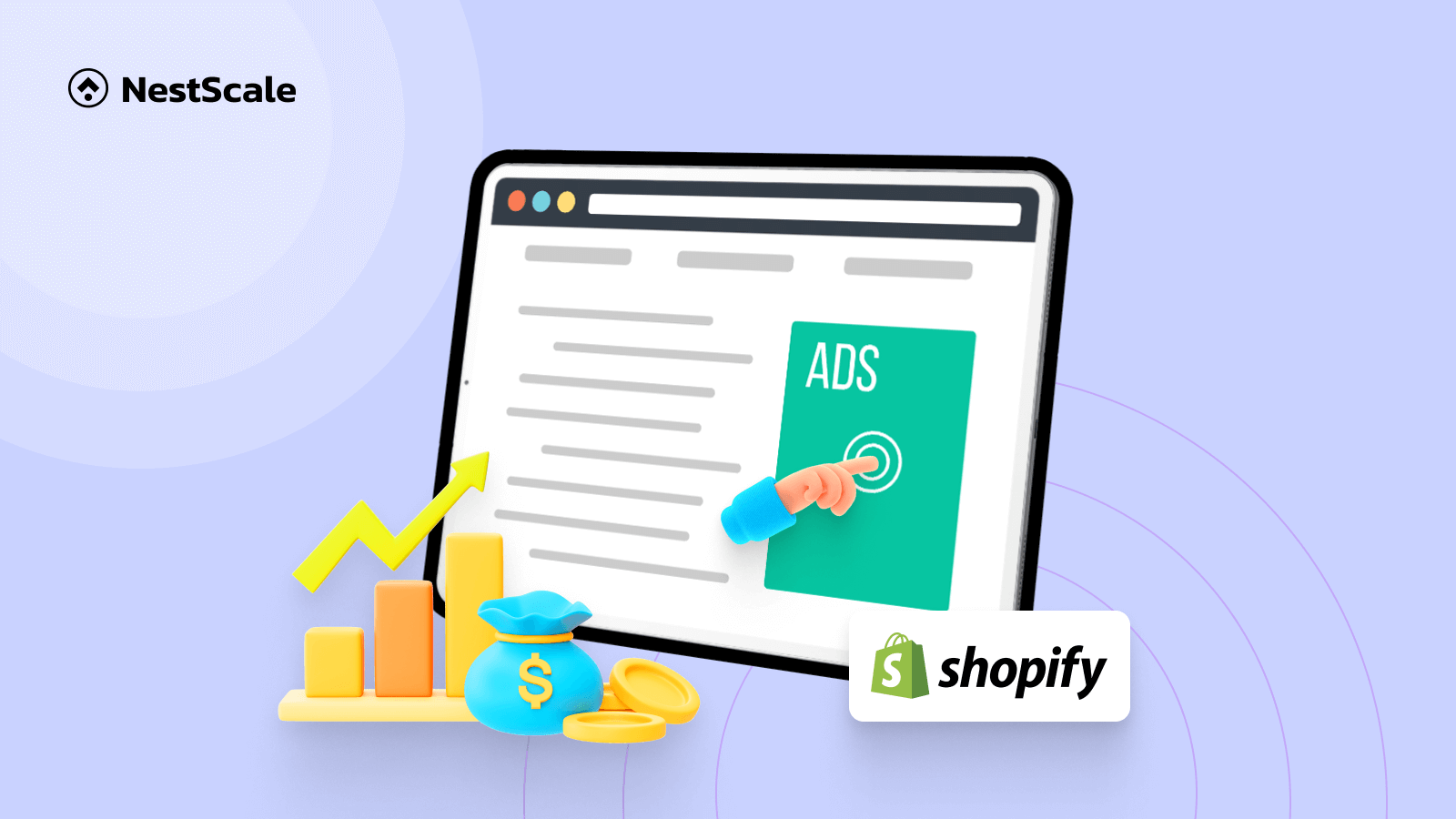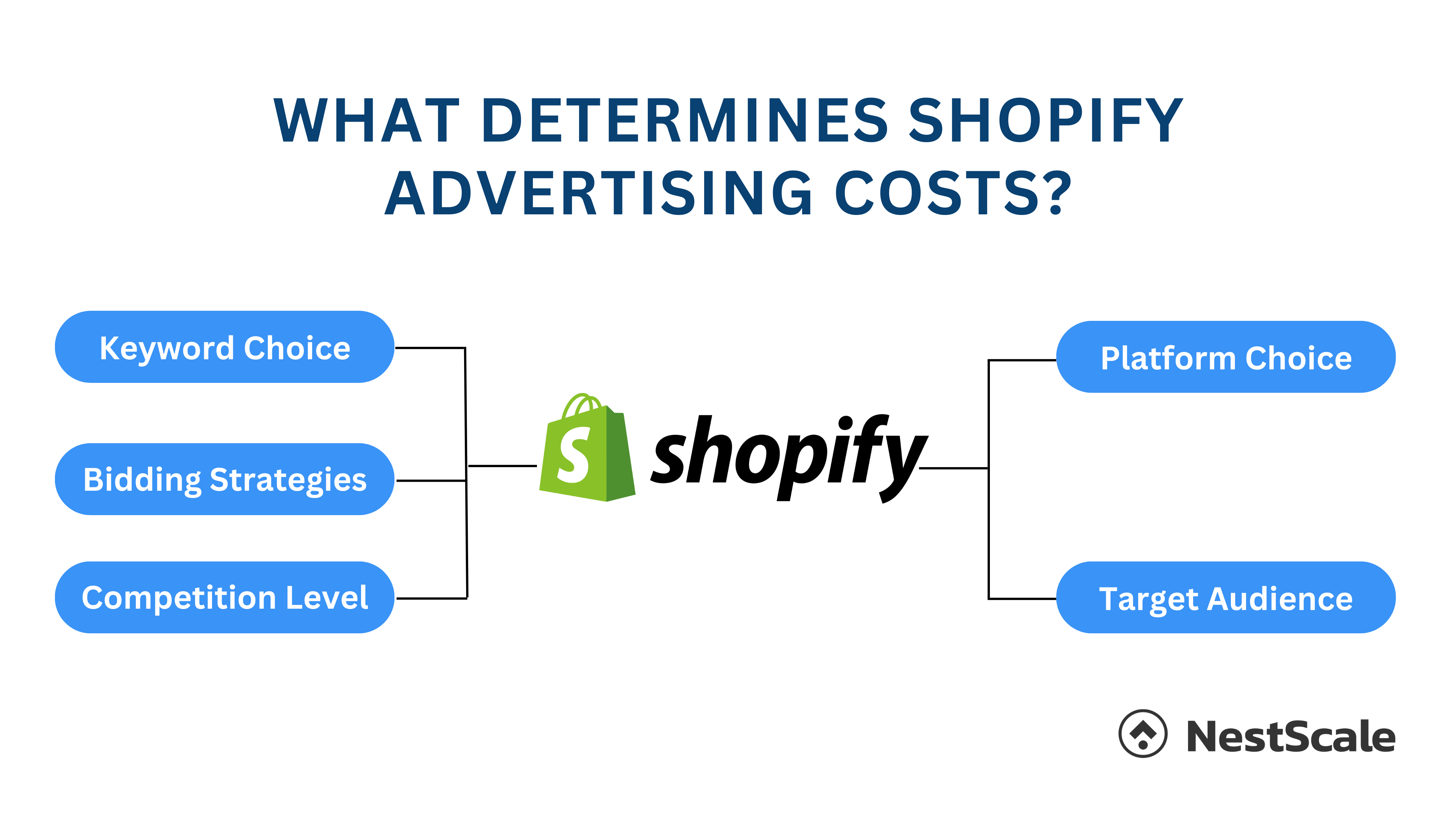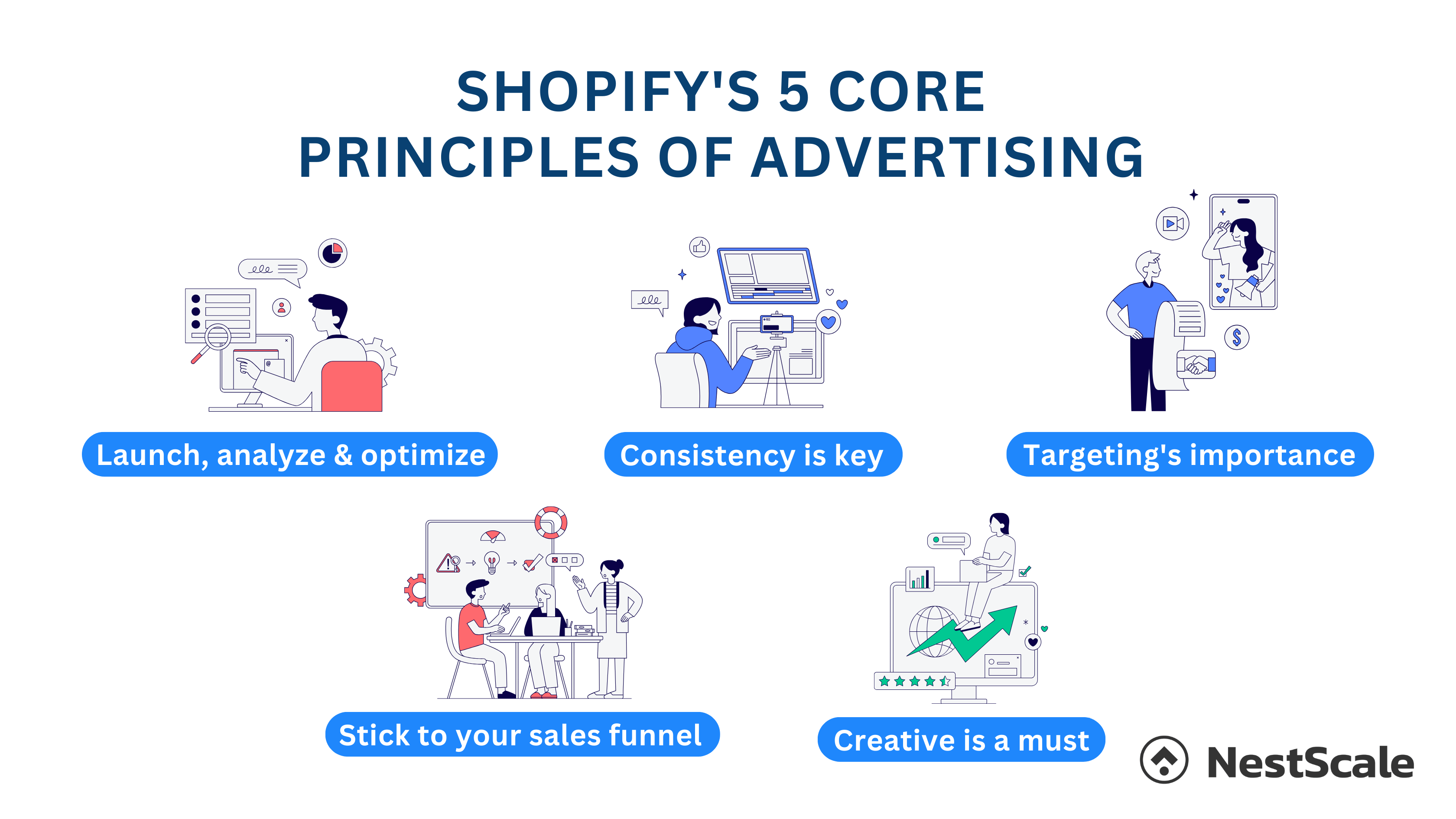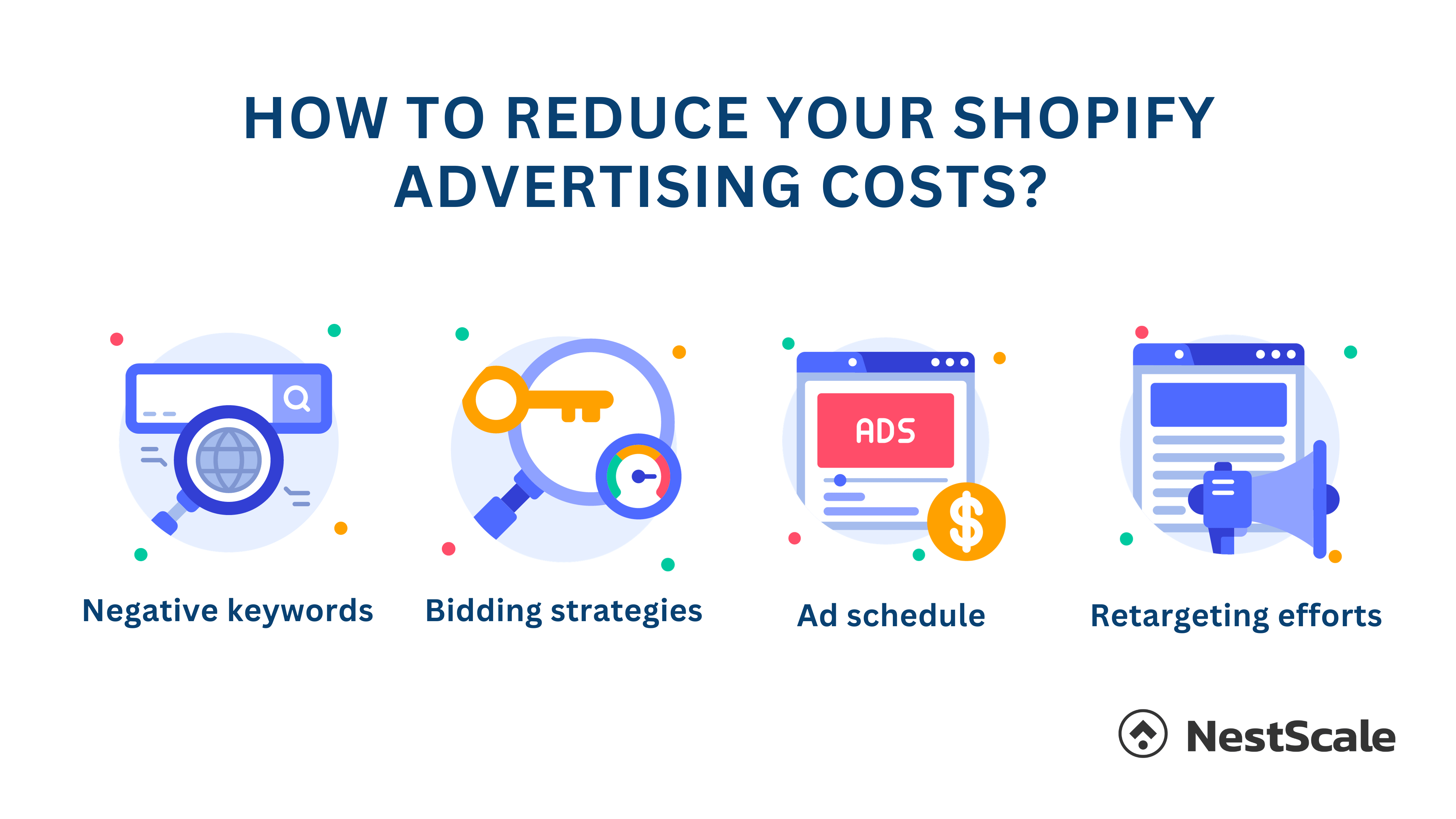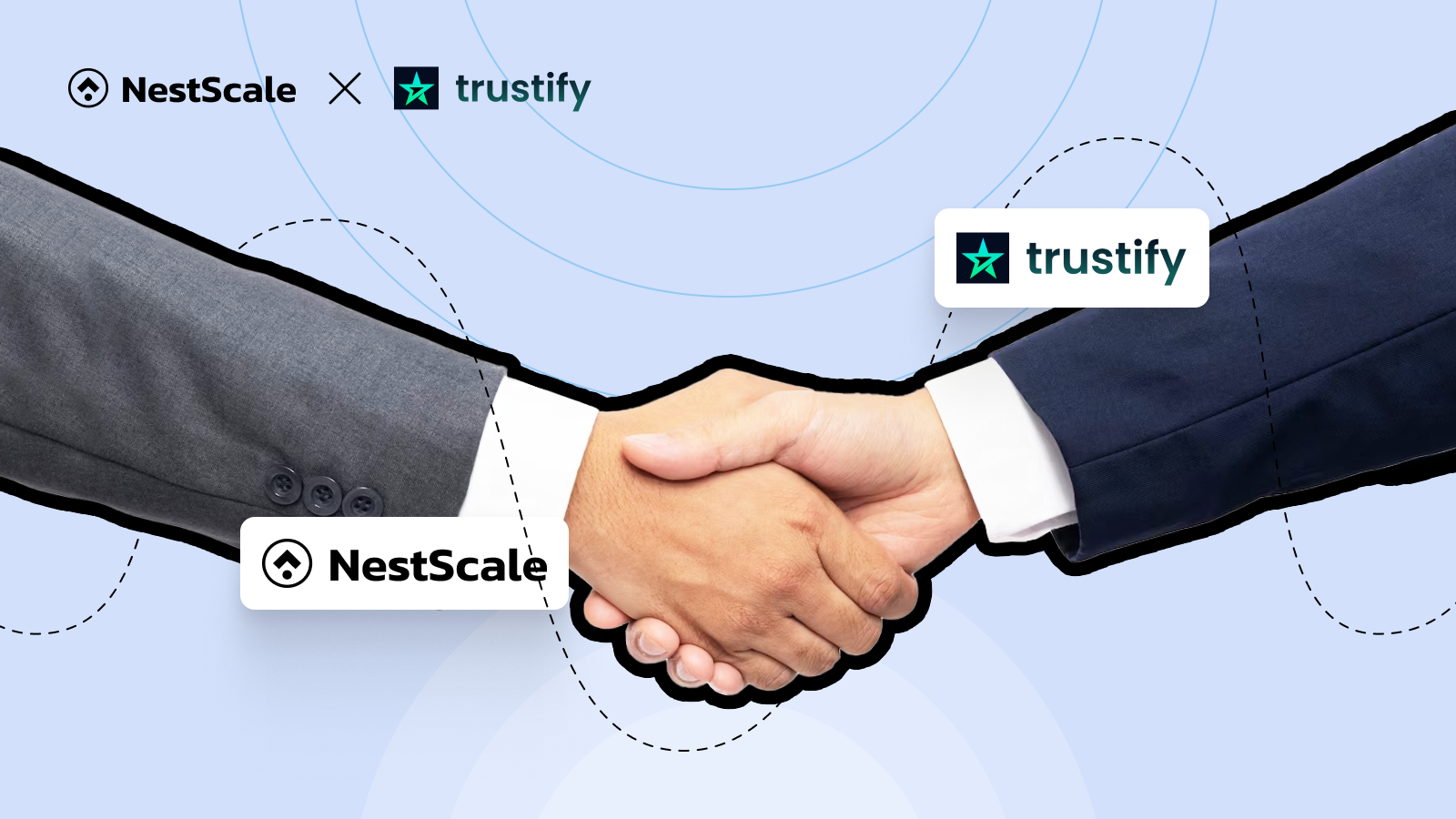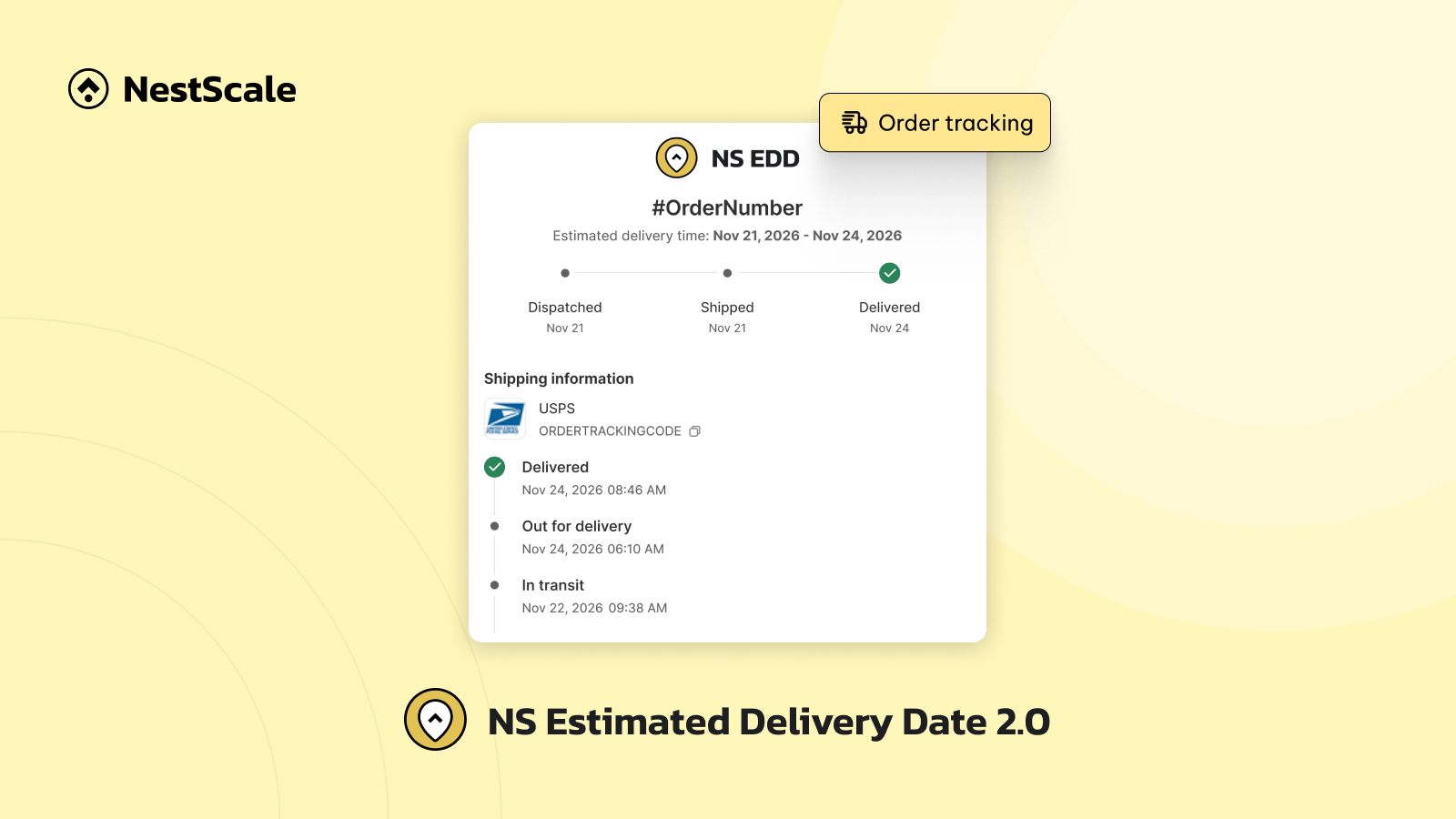Shopify has become a powerhouse in the field of e-commerce. As of 2023, there are more than 2 million Shopify merchants in the USA alone, and this number is expected to grow in the coming years. But let’s face it, running a Shopify store is not for the weak. There’s a multitude of business facets to navigate, with advertising activities, especially budgeting taking center stage. So, in this blog post, we’ll explore Shopify advertising costs and other factors involved. We’ll also go over Shopify’s 5 core advertising principles and some tips on how to allocate your budget on each of Shopify’s partner advertising platforms. Let’s dive in right away!
How much does Shopify advertising costs?
Shopify provides businesses with various marketing tools like Automation, Shopify Forms, Shopify Email, etc. to aid their marketing activities. In addition, Shopify also allows seamless integration with their advertisement partners: Google Ads, Facebook Ads, Instagram Ads, and YouTube Ads. Merchants usually incorporate the usage of both third-party advertising platforms and Shopify marketing tools to get their business to the right customers.
Regarding how much Shopify advertising costs, the expenses depend largely on your business goals, platform choice, target audience, sales, and more. And yes, that does sound ambiguous. However, there’s a handy formula to give you an advertising budget benchmark.
According to the Shopify team, your marketing spend should be in sync with your gross sales. More specifically, Shopify expert recommends reinvesting 10-30% of your total revenue into advertising. For example, if you store is pulling in $100 per month, setting aside around $10 for your advertising budget would be a smart move to ensure your marketing efforts are worthwhile.
“Anywhere from 10% – 30% of your topline revenue should be reinvested into paid amplification.”
Shopify Expert
Now, if you’re a Shopify newbie just dipping your toes into the e-commerce waters, you can start small. Platforms like Google Ads allow you to set a budget as low as $1- a perfect entry point. However, it’s worth noting that an excessively low budget might not give your ads the traction they need. A safe starting point could be around $5. This way, you can get acquainted with the platform, gather initial insights, test out strategies, and gradually refine your approach without breaking the bank.
What determines Shopify advertising costs?
So, if there’s no clear benchmark to base your ad spend on, what other factors can we rely on to estimate our Shopify advertising cost? As we have briefly mentioned in the previous section, there are various attributes that can influence how much your Shopify advertising cost. Some of them includes:
Keyword choice
This factor is more specific to search campaigns on platforms like Google Ads. If you’re bidding for broader, high-demand keywords, chances are your cost per click (CPC) will shoot up. So, it’s wise to strike a balance between broad and more direct keywords for your search campaigns.
Bidding strategies
Different platforms offer various bidding strategies, such as manual bidding and automated bidding. Your choice of bidding strategy can influence your costs and ad performance. So, if you want to have more control over how much you’re spending on certain keywords or ad, opt for manual bidding.
Competition level
You can also estimate how much you might need to spend on advertising by looking at how crowded your industry is. If it’s jam-packed with competitors, you might have to loosen the purse strings a bit to outshine the rest. It’s a no-brainer. When you’re in fierce competition with other advertisers for the same audience and keywords, the costs tend to rise.
Platform choice
The advertising platform you select (e.g., Facebook, Google) will have a great impact on your overall Shopify advertising cost. Since each platform has its unique pricing structure, cost per click (CPC), or cost per mille (CPM) rates, this diversity can result in fluctuating costs. In addition, each of these platforms offers different targeting options and ad formats that can influence your ad costs.
Target audience
The audience you choose to target can have a significant impact on your costs. If you have a highly competitive or broad target audience, your CPC or CPM might be higher. Meanwhile, a smaller, more well-defined target group can result in lower costs.
Shopify’s 5 core principles of advertising
The truth is, you can set your budget to whatever amount you wish. However, going with your gut might not always be the best choice, especially when it comes to Shopify advertising. So, Shopify has provided 5 advertising principles for businesses to abide by in order to actually see results and yield better outputs for your ad campaign. These are:
Consistency is key
A lot of people still think of advertising as a short-term activity – only to be adopted when you want a lot of sales right away. But in fact, there’s more to advertising than just that. When you’re running an ad campaign, you’re not only boosting the product, but you’re also spending money to buy data. You’re generating website visitors, repeated audience, and even leads.
And, you can achieve all of that without spending money consistently. Make sure you’re spending enough daily to see actual results and get your ads up and running. The longer you do this, the more data and insights you’ll have. Then, you can utilize these assets to tweak, adjust, and learn about your audience.
Launch, analyze and optimize
Well, this one kinda goes without saying. You simply cannot run a successful campaign without putting in the work. The process is fairly simple – Launch, analyze and optimize. Make sure to set up and get your ads running first. Once you get some performance data, monitor and analyze your findings to pinpoint high-performing ad creatives and settings. Then, gradually refine your ads based on the data you received. This way, you can turn the money you invested in ads into investments rather than letting it go to waste.
Emphasize the importance of targeting
Another rule to always keep in mind with Shopify advertising is the importance of targeting.
“If you put your ad in front of the wrong people it’s never going to work! The people you put your ad in front of have to be interested, so targeting is very important.”
Shopify Expert
So, before you jump into selecting your audience, take a moment to think it through. Go too broad, and your ads might miss the mark for relevance. Go too narrow, and you risk bombarding the same group of people repeatedly. Neither scenario is a win for your brand. That’s why it’s smart to sketch a crystal-clear picture of your ideal customer before kickstarting your campaign. If your audience feels a tad too vast, break it down by demographics, location, interests, or behavior. Test each segment to uncover the top-performing settings. Once you’ve nailed that down, setting up your ad targeting becomes a breeze.
Creative is a must
Now, most of what we’ve talked about so far deals with the more technical side of things. But hey, don’t go thinking we’re about to brush aside the importance of your ad creative. You know, the message, title, text, photo, or video that makes your ad pop. Even if your ads are perfectly optimized and being shown to the right audience, they won’t get those clicks unless the ad itself is interesting or downright irresistible. So, don’t snooze on your content. Double-check that your ad’s content is top-notch, your title is attention-grabbing, and your visuals are easy on the eyes. Just like with other parts of your ad, if you’re feeling a bit uncertain, give regular testing a shot to make sure your creatives are hitting the right notes.
Stick to your sales funnel
So, why is it so important to stick to your sales funnel and plan the advertising activities around each step? Well, let’s look at an example first. You have just launched your product on Shopify and are running awareness campaigns on Facebook. At this stage (top-of-funnel), your main concern should be to educate your customers and familiarize them with your brand. If you choose to send your customer a promotional discount code right away, it’s likely that they won’t convert. However, if you stick to your sales funnel and wait until the customers have actually shown interest in your products to send the discount code, the results will be much more positive.
How to set the advertising budget for each platform?
Now that we have learned Shopify’s 5 core principles of advertising, it’s time to put this knowledge to practice. In this section, we’ll list out some key components to consider when it comes to setting a budget for your campaign on some of the most popular Shopify partner advertising platforms. Let’s jump right in.
Facebook advertising budget
When it comes to Facebook Ads, there are some factors you should consider when deciding your advertising budget for your Shopify store. All of these elements will greatly influence your advertising budget, as well as the effectiveness of your campaign.
Campaign Goals
The first check box might sound like a given, but absolutely cannot be overlooked. What is your conversion event for this campaign? Is it sales, messages or engagement? How much revenue do you want to achieve? Or how many customers are you hoping will sign up via your form? Those are some of the questions you’ll have to answer in this initial step. Only through answering these questions will you be able to make some initial estimates regarding your advetising budget.
Here’s a formula you can utilize to link your campaign goals with your advertising budget:

For example, you aim for your business to reach $10,000 in revenue from Facebook ads in December and your total cost last month was $1,000. Let’s assume that the cost remains the same month over month. In this case, you need at least $10,000/$1,000 equals 10 sales in December to achieve your desired revenue.
Cost metrics (CPC, CPM, CPA)
Another factor that will greatly influence the cost of your Shopify advertising activities is the cost metrics – cost per click, cost per 1000 impressions and cost per acquisition. To get an overall budget estimate, you can look for industry benchmarks for specific cost metrics. For example, for the SaaS industry, Facebook’s CPC benchmark currently stays at $0.54. Similarly, the benchmark for Facebook’s CPM is $8.26. You could also use the average cost value of previous months as your own benchmark. Based on these number, we can kind of estimate how much we have to spend on Facebook Ads to achieve the campaign objectives we want.
Instagram advertising budget
Instagram – the social media channel with the main focus on media and visual-based content, will certainly bear some differences from other advertising platforms. Not to mention, the way the audience interacts with content on this platform also differs drastically from that of other platforms, which ultimately affects budgeting. So, besides the previous rules we mention for Facebook Ads, here are some elements to keep an eye on regarding Instagram ad budget.
Ad placement & duration
For a visual-oriented platform like Instagram, where your ad appears is a big deal. There are a variety of ad placement to choose from, such as Stories, Feed, IGTV, Reels. And based on these different placement and running period, the cost will also differ accordingly. While some placements might be pricier, they could offer superior visibility and user engagement, which ultimately might be worth it.
Influencer network
Instagram isn’t just a treasure trove of visuals and media diversity. It’s also the go-to spot for a bustling community of influencers. If you’re sensing that your Shopify store needs an extra boost in visibility, diving into Instagram’s active influencer and KOL (Key Opinion Leader) scene could be the game-changer. Sure, teaming up with influencers might dig a bit into your pockets, but the potential payoffs in terms of visibility, engagement, and sales are seriously worth considering. Just keep in mind, playing the influencer game can be a bit pricey, and it’s definitely a factor to weigh when planning out your advertising budget.
Google advertising budget
Google Ads is litle bit different from the other platforms since it is search-based. Here, a big emphasis is placed on keywords. Consequently, it will also greatly impact your advertising budget. Below are some tips to keep in mind when setting your Google Ads budget for your Shopify store advertising.
Daily to monthly advertising budget
One special thing about Google Ads is it allows users different approaches to their budget: daily, monthly or shared. You can set out an amount you’re willing to pay each day for your average daily budget. To check this, simply navigate to the “Budget” column under the Campaigns tab.
However, if you’d prefer to have an overview of your budget from the monthly standpoint, you can multiply your daily budget by 30.4 (a.k.a the average number of days per month) to get your monthly ad spend.
The last option is the shared budget, which essentially refers to the amount you’re willing to pay across multiple campaigns. One advantage of shared budget is the Google Ads algorithm will make use of the leftover budget from weaker campaign to allocate to potential high-performing campaigns that are more likely to convert. This feature is not only effecient, but also eliminates ad spend waste.
Bidding options
Contrary to popular belief, Google Ads bidding isn’t all about the highest bid amount. Google Ads actually decides the winner based on both a combination of bid amount and ad quality. So, you don’t necessarily need to set your bid too high to win an auction. As long as your ad creative is of high quality, your keywords are relevant, and your bid is competitve, you stand a chance of winning. It’s also worth noting that most people end up paying less than their maximum bid. So, fine tuning your ad creatives and thoroughly researching your keywords might be the key to winning ad position with a lower budget.
Keywords costs
We all get it – some keywords just cost a lot more than others. Why? Well, it’s usually because they’re in high demand, with a bunch of folks all trying to bid on them at once. Now, the smart move here is to hunt down those high-traffic, low-competition gems. To make the most of your keyword budget, mix it up with a blend of broadened terms and more direct ones. This method will ensure enough people are seeing your ad, while still be able to t Plus, this tactic keeps you from splurging on those hefty, broad keywords that marget more specific customer needs and drive conversions. Another tip is to also utilize competitor keywords and high-intent terms with heavy action phrases like “Buy Now” for further testing. Once you’ve been bidding on your keywords for a month or so, check out the keywords report to pinpoint high-performing keys and eliminate the weaklinks that are eating up your budget.
How to reduce your Shopify advertising cost?
One question that almost all businesses on Shopify find themselves asking “What can I do to reduce advertising cost?” Besides setting a suitable budget for your campaign, there are some actionable steps to help you optimize your spending without compromising on the effectiveness of your campaigns. These are:
Make use of negative keywords
This is probably one of the most frequently overlooked features despite their great functionality. With negative, businesses can reduce wasted ad spend by steering clear of irrelevant audiences. For example, a customer who is looking for very a specific “Adidas pink & white windbreaker” are unlikely to purchase a red windbreaker from a competitor brand. Here, businesses can list “Adidas” as a negative keyword to exclude viewers who are looking for the brand Adidas specifically. This precision will ensure that your ad budget isn’t squandered on irrelevant audience, thus resulting in better ROI.
Leverage UGC content in your ads
Setting up your ads with smart bidding strategies and well-researched keywords is crucial, but don’t overlook the power of high-quality ad content to attract customer attention. One highly effective method is to incorporate user-generated content (UGC) into your ads, such as customer reviews or videos. Why? People tend to trust real customer feedback over traditional ads from brands, making UGC a great way to boost credibility and drive engagement.
Start by featuring product reviews from your existing customers directly in your ads. This is a quick and low-resource way to enhance the trustworthiness of your advertising. For a more engaging approach, encourage your customers to share their experiences on social media. You can offer incentives, like discounts or giveaways, to motivate them to post about their purchases. This might take a bit more time and effort, but it’s worth it—UGC campaigns often result in higher engagement and conversions, helping you maximize the impact of your ad spend without breaking the bank.

Adjust bidding strategies
Alright, every advertising platform has their own set of bidding strategies. So, it’s a good move to check out these different bidding options and figure out which one suits your business the best. Typically, you’ve got two main choices: automated bidding or manual bidding. If you’re just starting out, it’s recommended to use automated bidding first to get the lay of of the land, then gradually adjust it with manual bidding. Generally, the key is to use a bit of both to really fine-tune your bids for maximum efficiency.
Review your ad schedule
This is also one of those key factor in deciding your ad budget. Analyze the performance of your ads at different times of the day and days of the week. By doing this, you can pinpoint the time period your audience are the most active. From here on, adjust your ad schedule to allocate budget to peak traffic hours, avoiding unnecessary spending during slower periods.
Leverage retargeting efforts
Customers aren’t going to choose you just because they’ve seen your ad once. So, after you’ve done all the above, it’s important to implement retargeting campaigns to reach users who have previously shown interest in your products. These campaigns can be more cost-effective, as you’re targeting an audience already familiar with your brand. As a result, youl won’t squander your budget on a completely new audience group and educate them about your brand all over again.
Another method to reduce your Shopify advertising costs
There are various ways to advertise your products and services on Shopify, either by using Shopify marketing tools or via Shopify partners advertising platforms like Facebook, Instagram, Google or Youtube. However, managing your assets on these platforms can be a painful task, especially if you’re a small business with limited resources.
But there’s no need to fret, as NestAds has come to the rescue. Designed for Shopify businesses advertising across various platforms, NestAds centralizes all performance data into one sleek dashboard. It’s time to say goodbye to switching between tabs, as NestAds is here to simplify the entire data monitoring experience. Another one of NestAds’ exceptional features is its data-driven multi-touch marketing attribution. This will allow businesses to precisely identify high-performing channels, ensuring appropriate budget allocation and preventing unnecessary spending on inefficient ones.
So, are you ready to take your Shopify advertising to new heights? There’s no time to hesitate – embrace NestAds today! Elevate your marketing game with a NestAds to make your journey smoother and more successful.




































